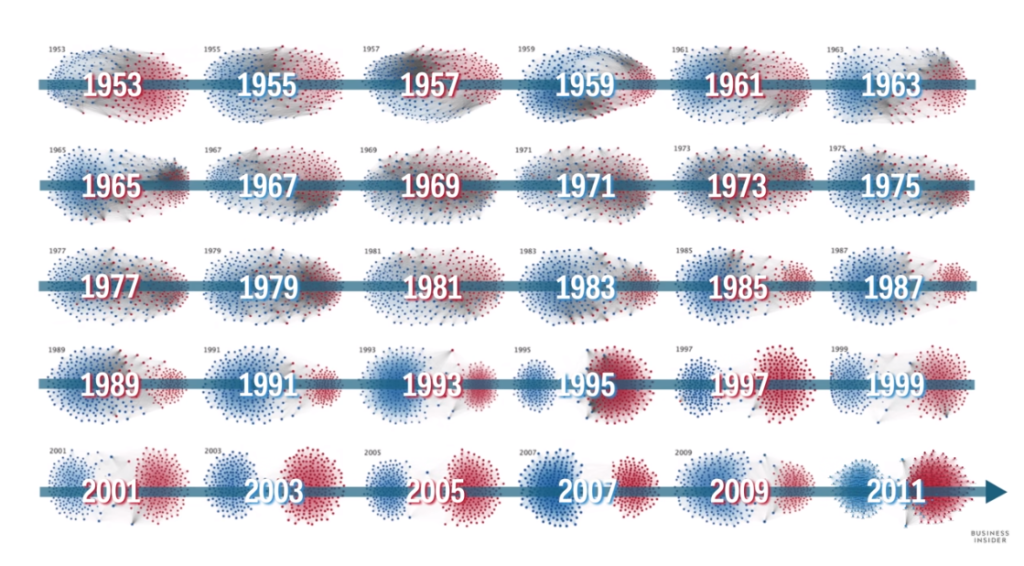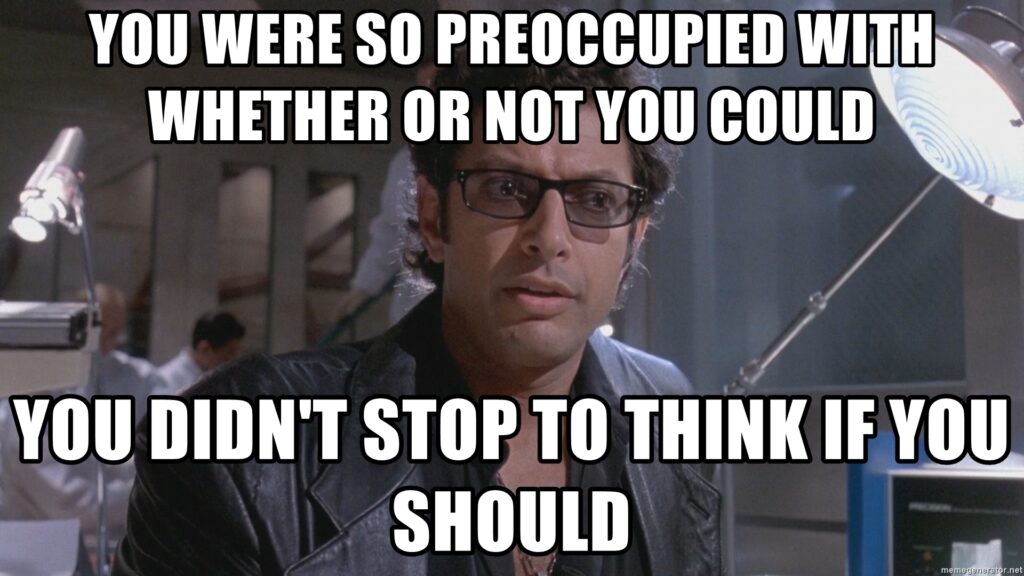Part 2 – Fake News and Social Engineering
Ever since I was old enough to pay attention to politics, I’ve always heard people tell me that whatever presidential election was coming up, it was “the most critical election ever.” I don’t know how true that is, but I’ve always been a little skeptical of the idea that presidential elections become consistently more critical over time. Over the last few months, however, I’ve found myself wondering we are seeing a trend. If I had to guess, I suppose there could be two major factors at play making everything seem consistently more dire, at least in the years since I’ve been paying attention: the increased consolidation of power in the executive office, and the increased polarization of our electorate.
This post will cover the second of those two: political polarization. Even before looking at any facts, it certainly feels like we as a society are more divided than ever. Driving through my neighborhood the other day, I saw a flag with the words “TRUMP 2020: Fuck Your Feelings.” Regardless of where you may find yourself on the political spectrum, I suspect you would agree that this is a level of polarization that we haven’t seen in our lifetime.
A fantastic animation from Business Insider shows the increasing polarization in the House of Representatives over time, starting in 1949 and ending in 2013.[1] Throughout most of the 20th century, there was a surprising amount of agreement across the aisle. Around the 1980s, there was a more noticeable partisan separation, and by the early 21st century, the divide was striking. If our representatives are becoming more entrenched in their positions, I have to imagine that is partly a response to the people they represent.
So what is changing with us? Certainly there are many factors at play, but arguably the most significant difference between life now and 50 years ago is how we get our information and interact with each other. On one hand, it is incredible that we are able to stay in such quick and easy contact: I can wake up, open Facebook, and see what a friend in Tokyo is eating for dessert. (I have no idea how he is or what’s new with him, but I have full access to the minutiae of his daily life.) On the other hand, the capabilities of our technology have already outpaced our ability to adapt to them on several fronts: our biology, our psychology, our regulations, and our ethics.

Image credit: [2]
“The Social Dilemma”
For example (starting simply), looking at a phone screen in the evening bombards your retina with light from the blue end of the visible spectrum, confusing your brain into thinking it’s daytime and therefore delaying the release of melatonin, which helps you sleep.[3] Our bodies are slow to evolve, and it isn’t something you can simply talk your brain out of doing.
A little more sinister is how our phones and social media can impact our psychology and become addictive. Getting reactions, likes, feedback, notifications, etc. on social media releases dopamine in the brain, creating a good feeling. Dopamine is associated with food, exercise, sex, gambling, and drugs, among other things, and the feeling can become addictive.[4] In fact, social media apps are designed with that brain chemistry in mind so you use them more. The short-term responses we get in the form of likes and shares create a perceived sense of value when they are present – and the opposite when they aren’t, reinforcing that cycle of posting content and looking for feedback.
There’s a saying that if a product is free, you’re actually the product. The 2020 documentary “The Social Dilemma,”[5] available on Netflix, goes into much more detail about the specific techniques app developers employ to addict their users. (They also point out that “there are only two industries that call their customers ‘users’: illegal drugs and software.”) This claim is not simply an accusation: the developers interviewed in the documentary have described their own addictions to the apps they create, as well as the limitations they put on social media use for their own children.
So what’s the point in addicting us to social media? On the surface, social media platforms earn revenue from the advertisements we see. The more we pick up our phones and check our newsfeeds, the more money they earn. However, there’s another level to it too: these platforms record our data – not just where we live, our relationship status, and what links we click, but also how quickly we scroll through content and how long we pause on a given post.
Machine learning algorithms use our information to predict what we want to see, and those algorithms get better at what they do all the time. The information stored on you as an individual is extensive enough to impact your Facebook and Twitter feeds, your suggested videos on YouTube, and even your Google search results. Unfortunately since this tailored information is unique to each of us, it is easy to believe that everyone is seeing the same thing.

Image credit: [6]
The belief that we’re all working with the same set of facts has made it easier to react negatively when people don’t agree with us. If someone has the information you have and doesn’t see eye-to-eye with you, it’s incredibly easy to see that person as unreasonable. And in that “divided we fall” sense, it has become incredibly easy to manipulate us.
“The Great Hack”
After watching “The Social Dilemma,” I decided to rewatch 2019 documentary “The Great Hack,”[7] revisiting the Cambridge Analytica scandal in which Facebook data was used without the knowledge of Facebook users for the intention of influencing the 2016 Brexit vote and US presidential election. Prior to 2016, Cambridge Analytica was involved in “about 10” political campaigns a year throughout the world, using social media platforms to influence the outcomes – not simply with advertisements, but through more sophisticated targeted messaging.
Since the majority of voters have already made up their minds and aren’t going to change political position based on something they see online (indeed, many people go to the internet to confirm their beliefs, not to learn new information), Cambridge Analytica’s approach for elections was to identify and target messaging toward a group of voters that remained on the fence: those who may vote for one candidate or the other, or those who may or may not vote at all.
In the 2016 US election, they were able to identify people on the fence in swing states, such as Michigan, Wisconsin, Pennsylvania, and Florida, and further break down this group of “persuadables” by voting precinct. The idea is that by targeting enough “persuadables” in the right precincts, you could flip the state in the election. The tactic is not limited to placing static campaign advertisements in one’s newsfeed, but also increasing the amount of politically-charged content in the form of posts, videos, and events from other users – some of whom are real and some of whom are not. (There was evidence of Russia’s involvement in creating fake Black Lives Matter / Blue Lives Matter Facebook events.)
According to the documentary, “Donald Trump’s 2016 digital campaign director claimed to have run 5.9 million visual ads on Facebook, in contrast to Hillary Clinton’s 66,000,” and that 70,000 voters in three states ultimately decided the election. Some may argue that Trump simply ran a better campaign with the technology available, but there are many concerned about the ethics of this technology and the current lack of visibility and regulation around Big Data.

What’s the worst that could happen?
Image credit: [8]
Social media platforms themselves are designed to be addictive, but when paired with political propaganda, some have described them as “psy-ops” and “weapons-grade communication tactics.” It is concerning enough to consider the use of these tactics within a country, but the concern for national security grows when you consider the implications of foreign involvement in our elections.[9]
Where do we stand?
Out of curiosity, I asked a very conservative friend of mine what the makeup of his Facebook feed looked like politically. I have very few conservative friends on Facebook, and my feed is almost exclusively liberal content, which I assumed to be a function of my breakdown of liberal vs. conservative friends. My friend, on the other hand, told me that he similarly has very few conservative friends on Facebook, but his feed seems about half and half as far as content.
According to “The Social Dilemma,” fake news spreads six times faster than boring, middle-of the-road news. Social media enables a dopamine addiction that brings us back for hot-takes on the 24-hour news cycle, and we continue to feed the big-data machine that learns more about us and better predicts our behavior every time we log in. We can limit the data we provide, but we can’t stop it. Our best course of action now is to understand how our data can be used against us and to take some of the following steps: [10]
- use Qwant instead of Google[11]
- install Chrome extensions to remove recommendations
- don’t click on recommended ads or videos (you can navigate to them directly through your browser instead)
- keep devices out of the bedroom at night
- delete social media apps (you can navigate to them through your browser)
- turn off notifications
- (my personal favorite) follow people on social media who don’t agree with you!
And as always, do your own election research. (My annual spreadsheet is a good place to start.):
Thanks for reading!
[1] https://www.youtube.com/watch?v=tEczkhfLwqM
[2] https://www.youtube.com/watch?v=tEczkhfLwqM
[3] https://www.sleepfoundation.org/children-and-sleep/how-blue-light-affects-kids-sleep
[4] https://now.northropgrumman.com/this-is-your-brain-on-instagram-effects-of-social-media-on-the-brain/
[5] https://www.imdb.com/title/tt11464826/
[6] https://memegenerator.net/instance/68967340/malcolmiann-you-were-so-preoccupied-with-whether-or-not-you-could-you-didnt-stop-to-think-if-you-sho
[7] https://www.imdb.com/title/tt4736550/
[8] https://www.decades.com/quiz/how-well-do-you-remember-the-twilight-zone-episode-to-serve-man
[9] https://www.npr.org/2019/07/12/740771021/carole-cadwalladr-how-did-social-media-manipulate-our-votes-and-our-elections
[10] https://www.thesocialdilemma.com/
[11] https://www.qwant.com/?l=en
2 Comments
November 2020 Elections, Part 1 – Political Identity – Radical Moderate · January 14, 2021 at 10:37 pm
[…] November 2020 Elections, Part 2 – Fake News and Social Engineering September 27, 2020 […]
November 2020 Elections, Part 4 – Decisions, Decisions – Radical Moderate · January 14, 2021 at 10:42 pm
[…] [2] https://radicalmoderate.online/november-2020-elections-part-2/ […]